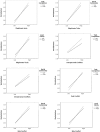It's Been a Hard Day's Night and I've Been Working Like a Dog: Workaholism and Work Engagement in the JD-R Model
- PMID: 31293485
- PMCID: PMC6598113
- DOI: 10.3389/fpsyg.2019.01444
It's Been a Hard Day's Night and I've Been Working Like a Dog: Workaholism and Work Engagement in the JD-R Model
Abstract
The study investigates if the job-demands resources (JD-R) model could be improved by including workaholism in its health impairment process. Salient predictors and antecedents of workaholism and work engagement are identified in a sample of 12170 employees at Norwegian universities and university colleges. Structural equation modeling suggested that job demands and job resources relate to workaholism and work engagement, respectively. The results also revealed that both workaholics and work-engaged employees put in more hours at work than was expected of them. We found that workaholism was negatively related to work-related health, whereas work engagement was positively related to work-related health. These findings support the notion of workaholism and work engagement as two different forms of working hard. Finally, we tested the buffer hypothesis that job resources would moderate the effect of job demands on workaholism. The moderations were in the expected direction, but effect sizes were weaker than those typically reported in previous investigations. In conclusion, the present study supports the expansion of including workaholism in the JD-R model.
Keywords: ARK; JD-R model; KIWEST; employee well-being; work engagement; work-related health; workaholism; working hard.
Figures




Similar articles
-
Balancing Work Life: Job Crafting, Work Engagement, and Workaholism in the Finnish Public Sector.Front Psychol. 2022 Mar 31;13:817008. doi: 10.3389/fpsyg.2022.817008. eCollection 2022. Front Psychol. 2022. PMID: 35432088 Free PMC article.
-
Individual Characteristics Influencing Physicians' Perceptions of Job Demands and Control: The Role of Affectivity, Work Engagement and Workaholism.Int J Environ Res Public Health. 2016 Jun 6;13(6):567. doi: 10.3390/ijerph13060567. Int J Environ Res Public Health. 2016. PMID: 27275828 Free PMC article.
-
Is workaholism good or bad for employee well-being? The distinctiveness of workaholism and work engagement among Japanese employees.Ind Health. 2009 Oct;47(5):495-502. doi: 10.2486/indhealth.47.495. Ind Health. 2009. PMID: 19834258
-
Work Engagement and the Validity of Job Demands-Resources Model Among Nurses in Japan: A Literature Review.Workplace Health Saf. 2021 Jul;69(7):323-342. doi: 10.1177/21650799211002471. Epub 2021 Apr 13. Workplace Health Saf. 2021. PMID: 33845692 Review.
-
Positive psychology in the working environment. Job demands-resources theory, work engagement and burnout: A systematic literature review.Front Psychol. 2022 Sep 20;13:1022102. doi: 10.3389/fpsyg.2022.1022102. eCollection 2022. Front Psychol. 2022. PMID: 36204770 Free PMC article.
Cited by
-
Ticket to Ride: A Longitudinal Journey to Health and Work-Attendance in the JD-R Model.Int J Environ Res Public Health. 2021 Apr 19;18(8):4327. doi: 10.3390/ijerph18084327. Int J Environ Res Public Health. 2021. PMID: 33921775 Free PMC article.
-
Tracing an Unyielding Work Compulsion: A Moderated Mediation Model of Abusive Supervision and Compulsory Citizenship Behavior.Front Psychol. 2021 Nov 29;12:746823. doi: 10.3389/fpsyg.2021.746823. eCollection 2021. Front Psychol. 2021. PMID: 34912271 Free PMC article.
-
The Workaholism-Technostress Interplay: Initial Evidence on Their Mutual Relationship.Behav Sci (Basel). 2023 Jul 17;13(7):599. doi: 10.3390/bs13070599. Behav Sci (Basel). 2023. PMID: 37504046 Free PMC article.
-
The Role of an Individual and a Situation in Explaining Work Addiction: Disclosing Complex Relations.Int J Environ Res Public Health. 2023 Mar 4;20(5):4560. doi: 10.3390/ijerph20054560. Int J Environ Res Public Health. 2023. PMID: 36901570 Free PMC article.
-
Healthy universities: Exploring the relationship between psychosocial needs and work-related health among university employees.J Workplace Behav Health. 2023 Mar 18;38(2):103-126. doi: 10.1080/15555240.2023.2194026. J Workplace Behav Health. 2023. PMID: 39011545 Free PMC article.
References
-
- Albrecht S. L. (2011). Handbook of Employee Engagement: Perspectives, Issues, Research and Practice. Cheltenham: Edward Elgar.
LinkOut - more resources
Full Text Sources
Research Materials

